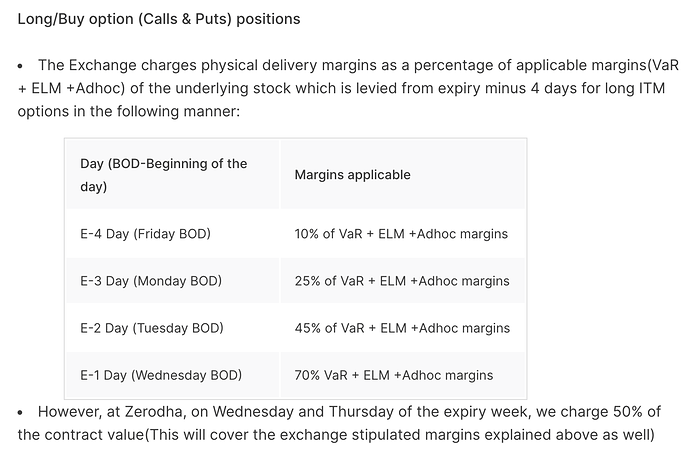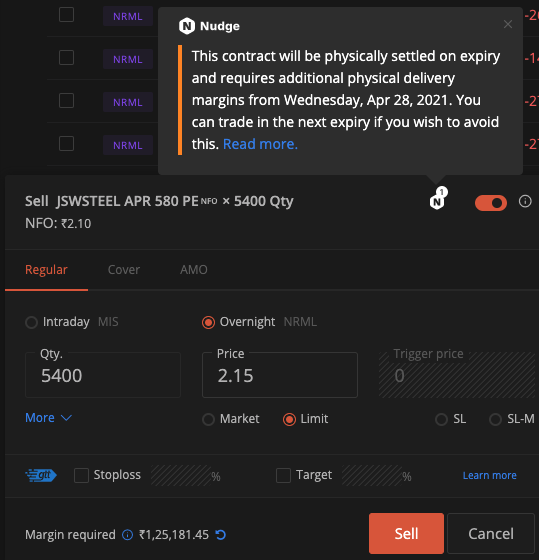Ok. I have being paying small penalty almost every month but paid 1.5L penalty somewhere in the month of Dec-Jan 2020 across my accounts and have been trying to figure out whats going on ever since. I am going to share my findings and how I have avoided paying anymore penalties since last three months. Hopefully, it will help especially for people who take pride in managing risk and utilising full margin. ( which is simply being over smart … in retrospect, at least for me ![]() )
)
Btw, the rules that changed are largely around -
- margin reporting becoming intraday on per client basis.
- margin shortfall penalties.
- physical settlement of equity derivatives and relevant exposure increase from T-4.
- being allowed to take derivative positions around unsettled amounts.
- delivery margin 80% after sell in cash.
And I hope you are already aware of it. I won’t go much into those details but a much deeper shift in general.
So firstly, it is not just one rule, but a bunch of rules implemented over a period of last 1 year that has created a dangerous cocktail of high penalty environment. This is the biggest issue I faced while finding answers. You ask any support guy or check the forum and they will point towards one rule that you are now in conflict with. But nobody is going to dig deeper regarding how you got into this state.
So, the right question is not which rule has got me margin penalty this time, but what is my trading style that leads to a conflict with a given rule over a period of time.
I hope you see the irony in this and it helps change your perspective.
Secondly, I had a hard time understanding this basic fact -
A broker cannot be completely relied upon to calculate your margin.
This is a very important point. They may try their best to assess, but at the End of Day it is the file from exchange that decides your fate of penalty for the day. Basically, before this the reporting of shortfall / availability of funds was on per broker basis. But now, it is on per client basis. Have you shifted the locus of managing the margin yourself - probably not. We are still under the old impression which is -
If I was allowed to take a trade that means, I had the funds for it.
However, penalty is being imposed by exchange and only collected by the broker. But inherently, we all depend upon our broker to provide us with available margin and exhausting the limit makes us believe that we are still on the right side of the rules for broker won’t allows us otherwise, where in fact we have gone overboard. Also, in certain circumstances a broker will provide you with higher margin and that is still a shortfall from exchange point of view. Plus, due the the basic nature of VaR always changing everybody is just catching up with the exchange requirements.
For example, take the following rule -
So, if you think about it - exchange is charging higher margin on Friday and Monday, but the broker is not. They only start charging higher from Wednesday. Hence, the right question to ask your broker is not how much margin you allow me to use but how much money you report I have utilised to the exchange that I wasn’t supposed to. Also, notice this is not EoD but BoD. That means at 9:15 AM on Friday even before the expiry week has started. This has hunted me the most and I used to get 2 strikes invariably after which there is even a higher bracket. Btw, same is the case with unsettled balances being allowed to trade with.
Thirdly, the opaqueness and missing transparency makes you keep shooting in the dark. A penalty is charged in your ledger 10 days after the shortfall. Similarly, interest short falls (50% collateral and 50% free cash) are charged in next month ledger. If there is one strike and I know about it instantly, I can avoid the next strike the next day but it is not straight forward to figure it out from contract notes especially, if you have collateral margin.
Lastly, the blunder I did with unpledge cost me the dearest. It was like I already had 4 strikes and the next penalty was going to be the huge. (though I was not aware I had 4 strikes). But here again a mindset shift is probably what was required.
When you pledge, the broker makes sure that you have the necessary shares to pledge. But when you unpledge, does the broker makes sure that you have necessary funds to unpledge?
That is the right question to ask. Again the locus is not with the broker but has shifted to you. I am not sure about this though. I do think Zerodha, has some checks of unpledge request going around 2 PM. But this is during market hours. Due to the nature of my trading (converting NRML to MIS), I would have passed the checks even if there was a shortfall and they honoured the unpledge request (when it should have been rejected) resulting to huge shortfall on the D day when I had all the strikes exhausted and there was considerable shortffall because there was a huge fall in the market increasing volatility as well. Looking back, maybe this check should be after market hours. I am not sure.
Btw, GST on penalty was the last straw for me, after which I had to figure this out - come what may.
Anyhow, rules I made to come out of this mess -
- Stop being arrogant. Margin of safety helps. Have 5% cash come what may. And I am not talking about Available Margin or Available Cash under Funds, but a new term I introduced for myself which should probably be called Real Cash.
Real Cash = Available Cash - Short Option Premium (From Console)
Real Cash >= 5% of Account Value (From Console)
This should address all your VaR intraday changes. And its brilliant because it excludes Short Option Premium (if you are an option seller) and gone ITM, Available Cash gives a false sense of moneyness in your account when there is none.
-
Take control back and you are responsible for your margins. Exit all near month trades by Thursday of the week before expiry. Especially, if you can’t maintain real cash equal to 10% of Account Value on Friday and 25% on Monday. Note that this is on BoD basis.
-
Deal with the following requests, that eat your money very carefully -
3.1 Unpledge request. Maintain Real Cash = 5% of AV + Total Amount To Be Unpledged.
3.2 Share Purchase. Maintain Real Cash = 5% of AV + Amount of Shares To Be Purchased.
3.3 Share Sell. Maintain Real Cash = 5% of AV + 20% of Amount of Shares To Be Sold.
And after understanding the issue and following the above said rules, I must say, I have no penalties since last 3 months. I think the biggest take away from all the complicated rule change is -
You are responsible for your margins and it is not wise to depend or give control of it to anyone else. And surely, margin of safety though a value investor concept is applicable in all walks of life.
Hope this helps.

